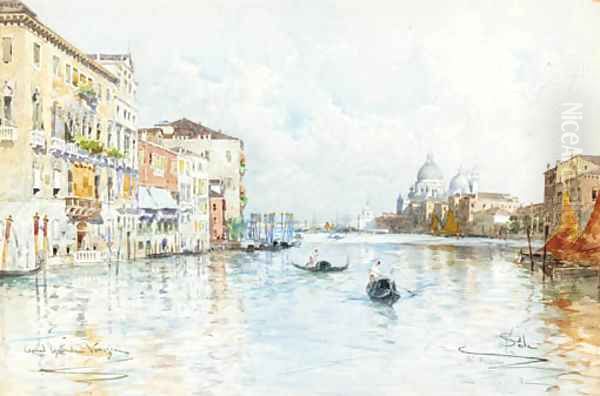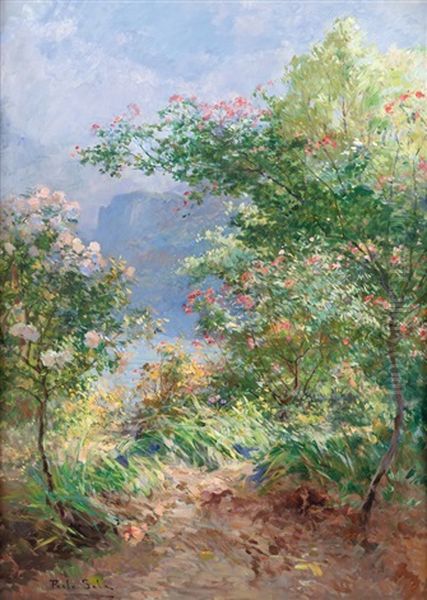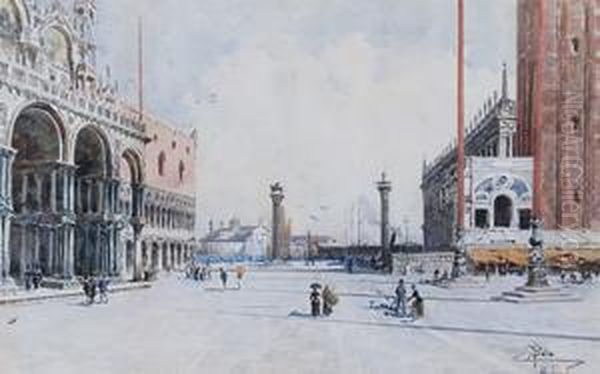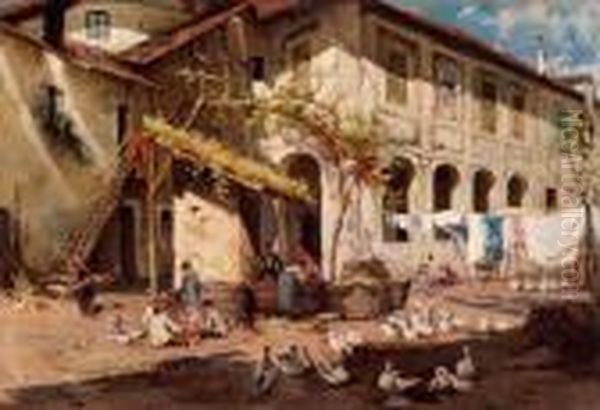Paolo Sala (1859-1924) stands as a significant figure in Italian painting during the late nineteenth and early twentieth centuries. An artist deeply rooted in the Lombard tradition yet responsive to broader European artistic currents, Sala carved a niche for himself primarily through his evocative landscapes, sensitive animal paintings, and vibrant depictions of Italian life. His work is characterized by a keen observation of light and atmosphere, rendered with an elegant brushstroke and a nuanced understanding of color, often aligning him with the broader Impressionist sensibility as it manifested in Italy.
Born in Lombardy, the region that would remain a constant source of inspiration throughout his career, Sala gravitated towards Milan, the artistic and cultural hub of Northern Italy. It was here that his formal artistic training took shape, providing the foundation upon which his distinct style would be built. His life spanned a period of immense change in Italy and Europe, witnessing the consolidation of the Italian state and the dynamic evolution of modern art movements.
Sala's legacy is that of an artist who captured the beauty of his native land with sincerity and skill. He translated the transient effects of light on water, the rustic charm of the countryside, and the energy of urban scenes into paintings that continue to resonate with viewers today. His contribution lies not only in his individual works but also in his role within the Milanese art scene and his participation in the wider dialogue of European painting at the turn of the century.
Early Life and Artistic Formation at Brera
Paolo Sala's artistic journey began in earnest at the prestigious Brera Academy (Accademia di Belle Arti di Brera) in Milan. This institution was a crucible of artistic talent in Italy, having nurtured generations of artists and played a central role in the development of Italian Neoclassicism and Romanticism, notably under figures like Francesco Hayez. For Sala, entering Brera meant immersing himself in a rigorous academic environment while also being exposed to the burgeoning modern art movements filtering into Italy.

During his time at Brera, Sala formed a significant connection with Camillo Boito. While Boito is perhaps more widely remembered as an architect, writer, and influential art critic, his early engagement with painting provided a context for mutual learning and artistic exchange with Sala. Their shared studies and discussions likely sharpened Sala's observational skills and encouraged his exploration of different themes and techniques. This period was crucial in shaping his foundational skills and artistic outlook.
Sala's talent was recognized early on. He was awarded the Mylius Prize (Premio Mylius) by the Milan Academy of Fine Arts for his history painting, Tramonto del 4 giugno 1859 (Dopo la battaglia di Magenta) – Sunset on June 4, 1859 (After the Battle of Magenta). This award not only provided financial support but also served as significant validation of his abilities, boosting his confidence as he embarked on his professional career. The choice of a historical subject, tied to the recent events of Italian unification, reflects the academic expectations of the time, though Sala would soon gravitate towards different genres.
His brother, Elia Sala, also pursued an artistic path, studying at Brera and eventually becoming a noted sculptor. This familial connection to the arts likely provided both support and perhaps a stimulating sense of creative dialogue or friendly rivalry, further embedding Paolo within the Milanese artistic milieu. The environment at Brera, combined with these personal connections, set the stage for Sala's evolution as a painter.
Development of an Impressionistic Style
While initially engaging with historical and figurative subjects, as evidenced by his Mylius Prize-winning painting, Paolo Sala's artistic focus gradually shifted towards landscape and genre scenes. It was in these areas that he developed his most characteristic style, one marked by a sensitivity to light and atmosphere that aligns him with the broader Impressionist movement, albeit with a distinctly Italian flavour. He became adept at capturing the fleeting moments of daily life and the transient effects of weather and time of day on the environment.
Sala's approach was not a direct imitation of French Impressionism, as practiced by artists like Claude Monet or Camille Pissarro. Instead, it represented an Italian interpretation of similar concerns. Like the French masters, he was deeply interested in how light interacts with surfaces, defines form, and evokes mood. His brushwork became looser and more expressive than purely academic techniques allowed, employing clear, elegant strokes to build up texture and luminosity.

His color palette was often soft and harmonious, yet capable of vibrant bursts to capture the brilliance of Italian sunlight or the specific hues of a Venetian lagoon. He excelled in rendering atmospheric effects – the haze of a winter morning, the shimmering heat of summer, the reflections on water. This focus on capturing the impression of a scene, rather than a minutely detailed topographical record, is the core of his connection to Impressionism.
Compared to the earlier Italian Macchiaioli movement, led by artists such as Giovanni Fattori, Silvestro Lega, and Telemaco Signorini, who used patches ('macchie') of colour to define form and light, Sala's technique was generally more fluid and atmospheric. He also differed from the later Italian Divisionists like Giovanni Segantini (another Brera alumnus), Gaetano Previati, or Angelo Morbelli, who employed scientifically separated dots or lines of colour. Sala's style remained more personal and less tied to specific theoretical frameworks, prioritizing visual sensation and emotional response.
Favoured Themes and Representative Works
Paolo Sala's oeuvre is rich with depictions of the Italian landscape, particularly the rural environs of his native Lombardy and the unique beauty of Venice. He possessed a remarkable ability to find artistic potential in everyday scenes, elevating them through his sensitive handling of light and colour. His works often feature pastoral settings, waterways, and architectural elements, populated by figures engaged in daily activities or simply integrated into the landscape.
Animal painting, especially within rural contexts, was a significant aspect of his work. He depicted livestock with empathy and accuracy, capturing their forms and movements as integral parts of the countryside tableau. Works like Ritorno al monte (Return to the Mountains) exemplify this interest, showcasing his skill in rendering both the animals and their surrounding environment with a sense of lived reality and atmospheric depth.
Venice, with its unique interplay of water, light, and architecture, was a recurring and beloved subject for Sala. He captured the grandeur of the Canal Grande (Grand Canal, Venice), the quiet charm of smaller canals, and the distinctive Venetian light with remarkable dexterity. These Venetian scenes often showcase his mastery of water reflections and his ability to convey the city's singular atmosphere, placing him in a long tradition of artists captivated by La Serenissima.

His depictions of Milan, particularly the iconic Duomo (Milan Cathedral), demonstrate his ability to handle complex architectural subjects while maintaining his focus on light and atmosphere. He painted both the imposing exterior and views from its heights, capturing the intricate details of the Gothic structure bathed in varying light conditions. These works stand as important visual documents of the city during his time.
Other notable works that highlight his thematic range and stylistic approach include Paesaggio primaverile (Spring Landscape), Ghiacciaio (Glacier), Ricordo d'inverno (Winter Memories), and Veduta di Venezia (Venice Landscape). The painting titled Rustico, created over a span of years (1895-1932, though the end date seems posthumous and might refer to exhibition history or a series), likely represents his engagement with rustic themes. His award-winning Tramonto del 4 giugno 1859 (Dopo la battaglia di Magenta) remains significant as an early success, showcasing his initial engagement with historical narrative painting before his definitive turn towards landscape.
Travels, Exhibitions, and Professional Activities
Paolo Sala's reputation extended beyond Milan and Lombardy. He actively participated in the national and international art scenes, exhibiting his work widely. His paintings were shown in major Italian cities, including Naples, Rome, Turin, and, frequently, Venice. Participation in prestigious exhibitions like the Venice International Art Exhibition (later known as the Venice Biennale) was crucial for visibility and recognition. His presence at the 1920 Venice Biennale, for instance, solidified his standing among contemporary Italian artists.
His work also found an audience abroad. Sala exhibited in prominent European art centres such as Paris and Berlin, indicating an awareness of and engagement with the broader currents of European art. This international exposure allowed his work to be seen alongside that of artists from different traditions, contributing to the cross-cultural dialogues that characterized the era. The reception of his work in these diverse venues speaks to the universal appeal of his sensitive depictions of light and landscape.
A particularly interesting, though perhaps less documented, aspect of his career involves time spent in Russia. Sources indicate he lived and worked in St. Petersburg for a period. Some accounts suggest he held a teaching position, occasionally mentioned in connection with a "Radlov Music Conservatory," although this specific institutional detail warrants careful consideration as his primary expertise was visual art. Regardless of the precise nature of his activities there, this Russian sojourn adds an intriguing international dimension to his biography, suggesting a breadth of experience beyond Italy.

Back in Milan, Sala played an active role in the local art community. In 1911, he was instrumental in founding the Associazione degli Acquarellisti Lombardi (Lombard Association of Watercolourists). This initiative highlights his commitment to promoting specific artistic mediums and fostering collegiality among artists in the region. Watercolour, with its inherent luminosity and transparency, was a medium well-suited to Sala's interest in light and atmosphere, and his leadership in this association underscores his dedication to his craft and his peers. His painting Transporte de hielo (Transport of Ice) was exhibited at the Galleria Pesaro in Milan in 1922, showing his continued activity late in his career.
Artistic Context and Relationships
Paolo Sala operated within a vibrant and evolving Italian art world. The late nineteenth and early twentieth centuries saw Italian artists grappling with national identity, academic traditions, and the influence of international movements like Impressionism and Symbolism. In Milan, Sala was contemporary with the later proponents of the Scapigliatura movement, such as Tranquillo Cremona and Daniele Ranzoni, known for their blurry, dematerialized forms and romantic sensibility. While Sala's style was generally clearer and more grounded in observation, the Scapigliatura's emphasis on atmosphere might have resonated with him.
His education at Brera placed him within a lineage that included not only Romantic masters like Hayez but also artists who would explore new directions, such as the Divisionist Giovanni Segantini. Later, Milan would become the birthplace of Futurism, with Umberto Boccioni (another Brera alumnus) and Carlo Carrà championing dynamism and modernity. Sala's work, however, remained largely focused on landscape and genre, representing a continuation of observational painting traditions infused with modern sensibilities of light and colour, rather than aligning with the radical avant-garde.
His relationship with Camillo Boito, primarily an architect and critic, connected him to the intellectual currents shaping architectural and artistic discourse in Italy. Boito advocated for a national style rooted in Italian traditions, a sentiment that might have influenced Sala's consistent focus on Italian subjects. His connection with his brother, the sculptor Elia Sala, provided a direct familial link to the practice of art, likely fostering a supportive domestic environment for his creative pursuits.
Beyond Milan, Sala's work can be situated alongside other Italian painters of his generation who engaged with light and landscape, such as the Paris-based Italians Giovanni Boldini and Giuseppe De Nittis, known for their dazzling society portraits and cityscapes, respectively. While their styles and subjects differed, they shared an engagement with modern life and contemporary painterly techniques. Earlier landscape painters like Antonio Fontanesi also form part of the broader Piedmontese and Lombard landscape tradition that Sala inherited and developed.
Sala's decision to found the Lombard Association of Watercolourists suggests a desire to build community and promote specific artistic practices, indicating his role not just as a solitary creator but also as an active participant in the organizational life of the arts in Milan. His consistent exhibition activity, both in Italy and abroad, further underscores his engagement with the professional art world of his time.
Critical Reception and Lasting Legacy
During his lifetime, Paolo Sala achieved considerable recognition. His regular participation in major national and international exhibitions, from Milan and Venice to Paris and Berlin, attests to the esteem in which his work was held. The acquisition of his works by galleries and private collectors, along with awards like the early Mylius Prize, further cemented his reputation as a skilled and respected painter. His ability to capture the essence of Italian landscapes and light resonated with contemporary audiences.
Academic and critical evaluations often highlight his mastery of light and colour, praising the elegance of his brushwork and the atmospheric quality of his paintings. He was seen as an artist who successfully blended traditional observational skills with a modern sensitivity to visual phenomena, particularly the transient effects of light. His works were appreciated for their lyrical quality and their affectionate portrayal of Italian scenes, both rural and urban.
However, like many artists whose styles bridge traditional and modern approaches, his work might have occasionally faced criticism. Some sources mention that his style was, at times, perceived by certain critics as perhaps too pleasing or "florid," a critique sometimes leveled at artists whose work emphasizes beauty and technical finesse over more radical or challenging subject matter. Nonetheless, the overall trajectory of his career suggests sustained appreciation.
In the broader sweep of art history, Paolo Sala is recognized as a key figure in Lombard painting at the turn of the century and an important Italian exponent of a style related to Impressionism. While perhaps not as revolutionary as the leading French Impressionists or the Italian Futurists who followed, Sala made a distinct contribution through his consistent dedication to landscape and genre painting, infused with a personal and sensitive response to light and place.
His legacy endures through his paintings, which continue to be admired for their technical skill and evocative power. They offer valuable insights into the Italian landscape and way of life during his era, captured with an artist's eye for beauty and nuance. His role in founding the Lombard Association of Watercolourists also points to his contribution to the artistic infrastructure of his region. Paolo Sala remains an important artist for understanding the diverse ways Italian painters responded to modernity while remaining connected to their rich artistic heritage.
Conclusion: Capturing the Italian Light
Paolo Sala's artistic career represents a dedicated exploration of light, colour, and atmosphere, primarily focused on the landscapes and life of his native Italy. From his formative years at the Brera Academy alongside figures like Camillo Boito, through his development of a personal, Impressionist-inflected style, to his active participation in the national and international art scenes, Sala consistently pursued a vision centered on capturing the visual beauty of the world around him.
His paintings of Lombardy, Venice, and Milan, his sensitive depictions of animals within their rural settings, and his mastery of watercolour demonstrate a profound connection to his subjects and his medium. Works such as Return to the Mountains, Grand Canal, Venice, and his views of the Milan Cathedral stand as testaments to his skill in rendering not just the appearance of a place, but its essential mood and character, often defined by the quality of light.
While navigating an art world undergoing significant transformation, Sala maintained a distinctive voice. He absorbed the lessons of Impressionism regarding light and momentary effects but filtered them through his own sensibility and the Italian artistic tradition. His founding of the Lombard Association of Watercolourists further highlights his commitment to craft and community.
Today, Paolo Sala is remembered as a significant Italian painter of the late nineteenth and early twentieth centuries, an artist whose work offers a luminous and enduring vision of Italy. His paintings continue to charm and engage viewers with their elegance, their atmospheric depth, and their celebration of the subtle beauty found in the interplay of light and landscape. He remains a testament to the enduring power of observational painting refined by a modern eye.